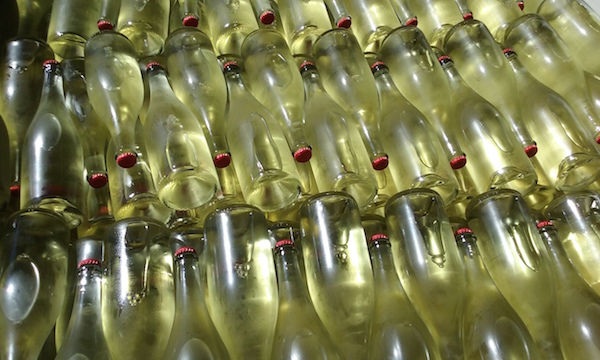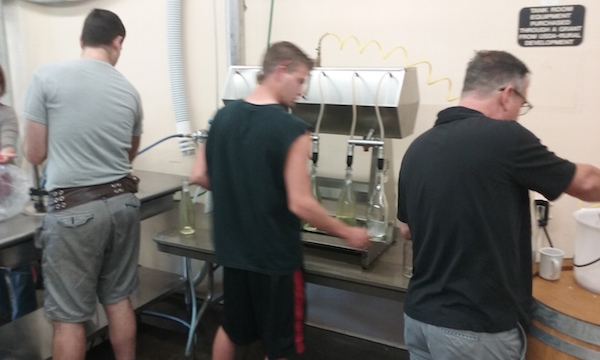
WALLA WALLA, Wash. — Class isn’t even in session, and yet Walla Walla Community College’s famed winemaking program has its first wine from the 2015 vintage in bottle.
Yes, enology instructor Tim Donahue and a handful of his future students bottled the College Cellars 2015 Muscat from Washington’s Yakima Valley on Friday, Sept. 11.
“I’d be willing to bet no one has beat us to the bottle,” Donahue told Great Northwest Wine with a chuckle. “When we talk about hands-on winemaking, we’re not blowing smoke.”
Donahue, winemaking director of College Cellars since 2010, said that while the Muscat is somewhat of a personal project, it has broad applications.
“We picked it Aug. 17 at about 22 Brix, and the total acid at harvest was around 7 grams,” Donahue said. “So we brought it in and did our magic in those 24 days. There may not be a lot of prestige to it, but it’s a lot of fun.”
College Cellars 2014 Muscat among nation’s best

The Colorado native also shows a tremendous amount of flair with Muscat. In January, the College Cellars 2014 Red Boar Vineyard Muscat Ottonel ($15) earned best of class at the San Francisco Chronicle Wine Competition — the nation’s largest judging of American wine.
This year, however, College Cellars needed to venture outside of the Walla Walla Valley for its Muscat, going just west of Red Mountain into Inland Desert Nursery. There, Donahue and a handful of future students picked Muscat Ottonel and Orange Muscat.
“Inland Desert Nursery swooped in and saved us,” Donahue said. “We had the hard winter damage, and some of the vines suffered in the Walla Walla. (Red Boar) wasn’t going to be able to do for us what it has been able to do in the years before.”
Despite the change of vineyards and blending two varieties, Donahue tried not to stray far from the chemistry of those three vintages off Red Boar.
“They are a little different,” Donahue said. “The Orange Muscat makes it much more dense in the aromas, and it’s a more intense wine. I let it carry a bit more alcohol and a bit less sugar. At 9.5 percent alcohol, it’s still not a whopping amount, and I dropped the sugar to 4.9 percent. The sugar used to be around 5.5 percent.”
College Cellars bottles 100 cases of 2015 Muscat

Friday, College Cellars bottled about 100 cases of their 2015 Muscat, half the production of its award-winning 2014 Muscat.
“We had about half of the incoming class, some of them who don’t know very much about wine yet, show up to bottle,” Donahue said. “They probably had no idea what was going on, but now when we talk about it in class, this experience will bring context to it. That’s how I like to teach — half academic and half practical. This was an example of that.”
The notion of using a quick-turnaround wine such as Muscat in his syllabus started in 2009 when he was studying in Australia, going through the master’s program at University of Adelaide, and bouncing ideas off instructor Stephen Clarke.
“Everything else we do at College Cellars is pretty traditional, but the idea of the Muscat started while having a couple drinks with Professor Clarke,” Donahue said. “He said you could it in 30 days and use it as a fun teaching tool of showing students how to make wine on a margin.
“It’s a good lesson in how to make a winery economically viable,” Donahue added. “There are a lot of great winemakers making great new wines, and we’re all trying to make the next big Syrah or Cabernet Sauvignon, but to make it work — unless you have someone like a Drew Bledsoe or Mike Corliss backing you — you’ve got to get the cash flow going to allow you to buy the barrels.”
And the College Cellars award-winning Muscat has a waiting audience.
“When we first did this back in 2012, the wine was a smash hit and we sold it out in about a month,” Donahue said. “And there’s a good reason for that. We release it near the start of school, and the teachers require some alcohol to get through that first week of classes.
“Something tells me about half of that wine stays on campus within the faculty of the college,” he added with a chuckle.
Retail price for the 2015 Muscat will hold steady at $15, and it’s built to chill and serve for immediate refreshment.
“A recent study has shown that for most wines, the average bottle is opened within 49 minutes of when it’s purchased,” Donahue said.
Donahue, assistant enologist Sabrina Lueck, viticulture instructor Jeff Popick and their students combine to create about 3,500 cases of wine each year.
The College Cellars tasting room is open Friday (11 a.m.-5:30 p.m.) and Saturday (11 a.m.-5 p.m.), and their wide range of award-winning wines also is available through wine merchants.

Leave a Reply